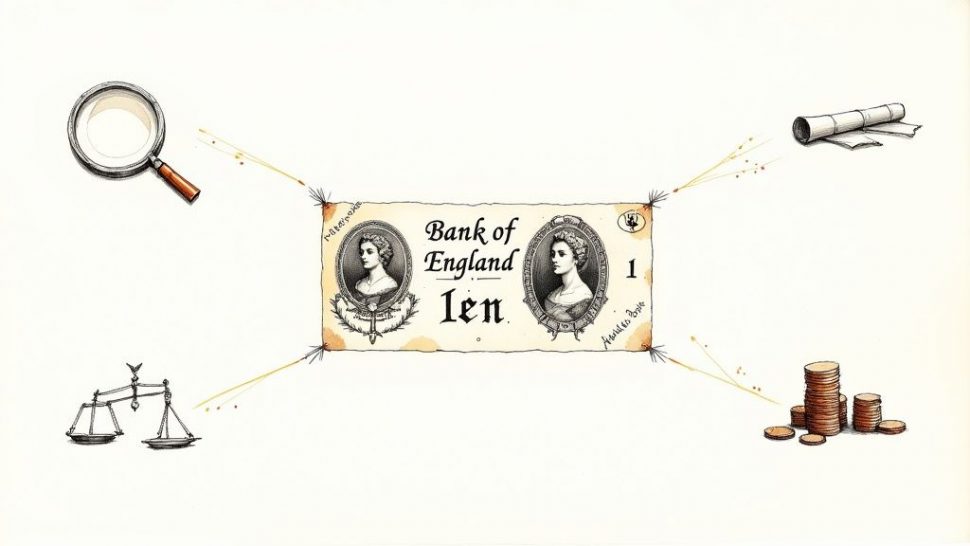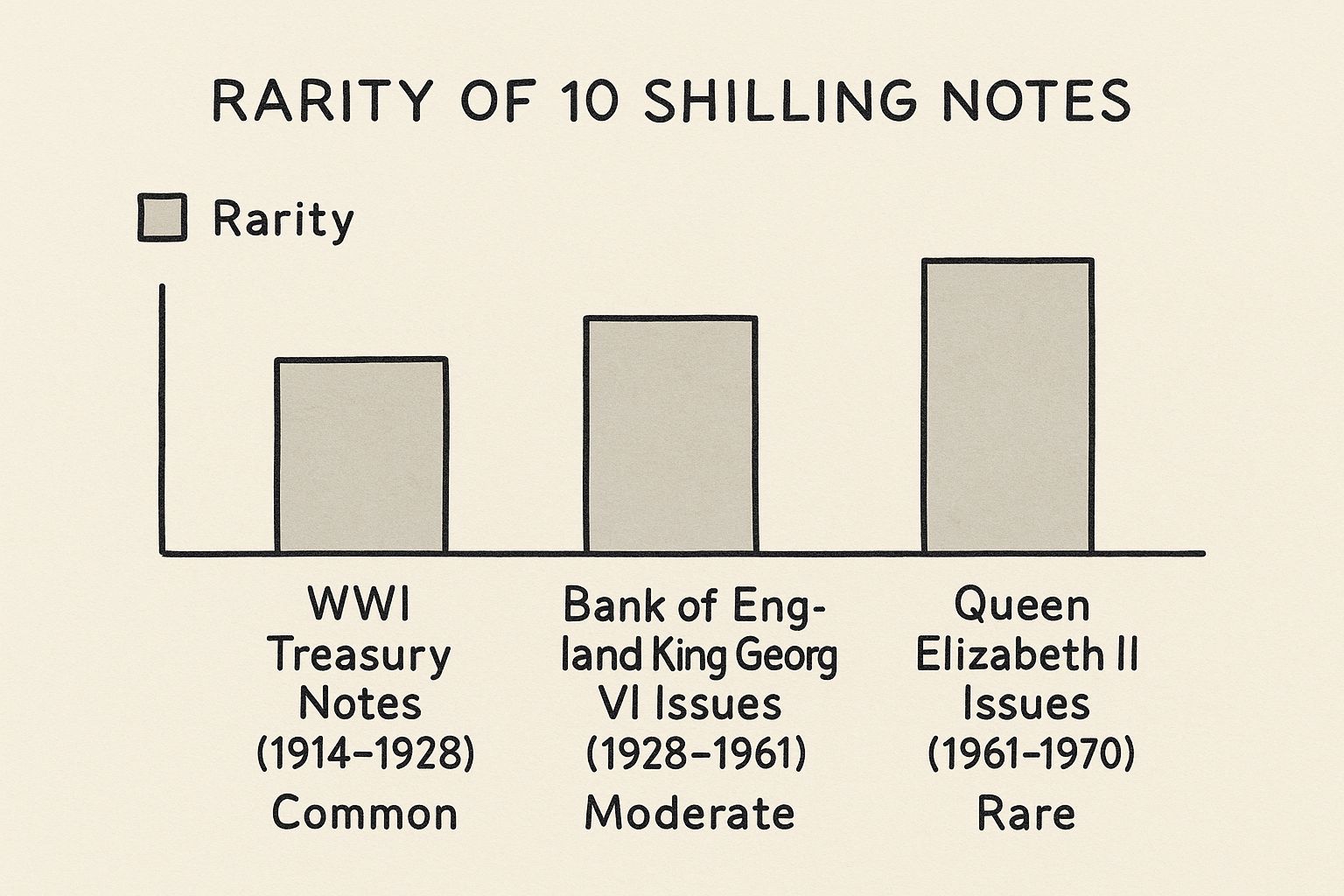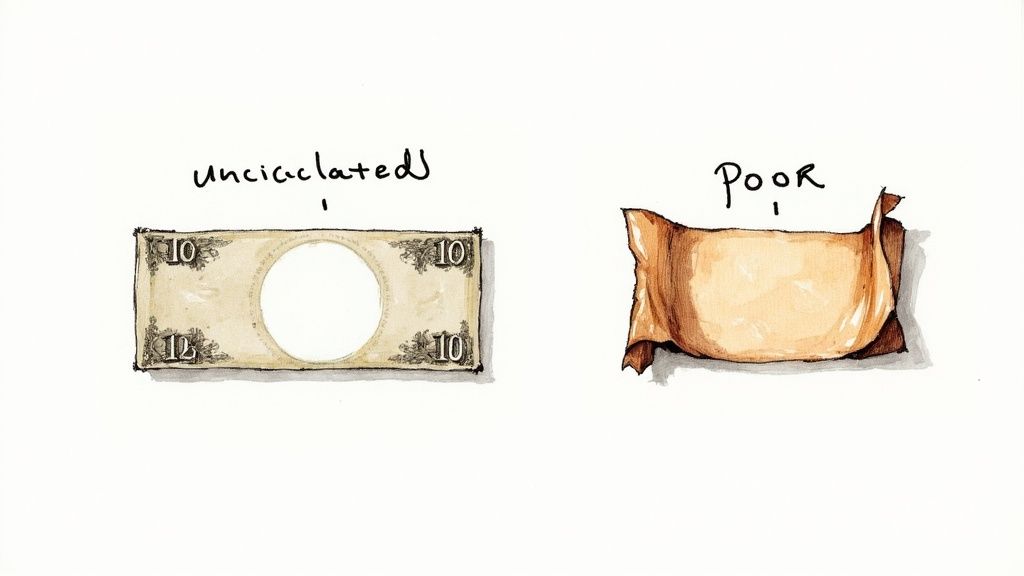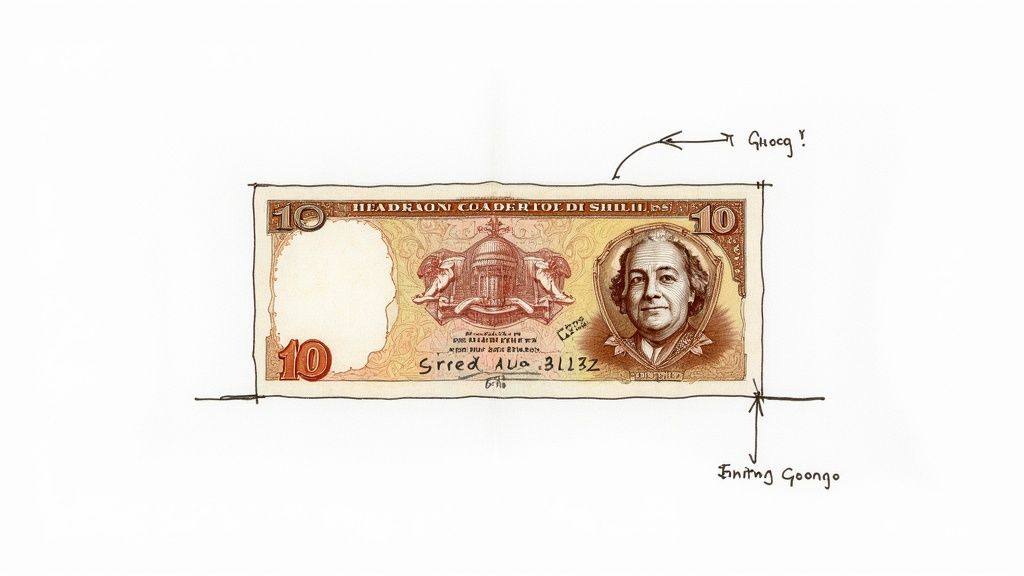How Much Is a 10 Shilling Note Worth? A Guide to Its Value

Posted by: Ian • 14 Oct 2025
That old ten bob note you’ve found isn't just fifty pence in old money. Its real value lies in what a collector is willing to pay for it, and that could be anything from a few pounds for a common, well-used note to hundreds for a rare, pristine example. The worth of your note comes down to its condition, its history, and its overall rarity in today's market.
Unlocking The Value Of Your Old Currency

Found an old 'ten bob' note tucked away in a book or a forgotten drawer? You might be holding a small but fascinating piece of British history. Before you dismiss it as obsolete currency, it’s worth understanding what makes these notes special. Think of them less as money and more as historical artefacts—their value has almost nothing to do with their original spending power.
The Bank of England's 10 shilling note was a cornerstone of daily life for decades. First issued in 1928, it represented half a pound sterling and was the smallest denomination the Bank ever printed. It was essential for everyday transactions until it was withdrawn from circulation on 22 November 1970, making way for decimalisation.
From Pocket Change To Collectable Item
So, how much is a 10 shilling note worth today? The answer is dictated entirely by the collector's market. A few key factors will determine whether your note is worth a couple of quid or a much more significant sum:
- Condition: A crisp, uncirculated note that looks like it just left the press will always be more valuable than one that’s been folded, stained, or torn.
- Rarity: Some print runs were much smaller than others. Notes with specific serial numbers or those signed by a particular Chief Cashier are far harder to come by.
- Historical Significance: Notes from the very first print runs or those with unusual features often command the highest prices.
To understand how money's value can shift so dramatically over time, it's interesting to look at the fundamental differences between fiat currency and cryptocurrency.
10 Shilling Note Value at a Glance
To give you a clearer idea, here’s a quick breakdown of what your ten bob note might be worth based on its physical state.
| Condition | Estimated Value Range (£) | Key Characteristics |
|---|---|---|
| Poor to Fair | £1 – £5 | Heavily folded, stained, torn, or has writing on it. |
| Good to Very Good | £5 – £20 | Shows signs of circulation with folds and some wear, but is still intact. |
| Fine to Extremely Fine | £20 – £50 | Lightly used with only minor folds; still crisp with clean paper. |
| Uncirculated (UNC) | £50 – £200+ | Pristine condition. No folds, creases, or marks. Looks brand new. |
This table is just a guide, of course. A particularly rare serial number or signature could push the value of even a circulated note much higher.
Whether you've found a valuable ten bob note, have leftover holiday money, or need to exchange foreign coins, our service offers a fast, easy, and hassle-free solution. We provide a 100% guaranteed process with no need to sort your currency, and we're trusted by major brands, airports, and police forces. Find out how you can exchange foreign coins and notes or even donate them to charity today.
The Story Behind the Ten Bob Note
To really get a grip on how much a 10 shilling note is worth today, you first need to know its story. The 'ten bob' note wasn't just pocket money; it was a slice of British history, shaped by decades of huge economic and social change. Its journey is exactly why some notes are so highly prized by collectors.
The note was born out of a national crisis. During the First World War, the government was desperate for a way to handle small, everyday payments. The Bank of England wasn't set up for this, as its smallest note was a hefty £5. So, in August 1914, the Treasury stepped in and started issuing its own 10 shilling notes. It was a massive shift, making paper money a part of daily life for the first time.
A New Era Under the Bank of England
In 1928, the job of printing the 10 shilling note passed over to the Bank of England, and this is where things get interesting for collectors. The design changed over the years, mirroring the shifts in the monarchy and national mood. Early notes carried the classic image of a seated Britannia—a powerful symbol of British strength.
Later on, the design was updated to feature the portrait of the reigning monarch. Notes from King George VI's era look quite different from the final series, which featured the iconic portrait of a young Queen Elizabeth II, first issued in 1961. That last design is the one most people remember with a bit of nostalgia.
This infographic breaks down the different eras of the ten bob note and gives a rough idea of how rare they are in today's market.

As you can see, the notes from the Queen Elizabeth II era are often considered the rarest. This is mostly because they were in circulation for the shortest time before the big switch to decimalisation.
The End of an Era
The ten bob note’s time finally came to an end in the run-up to decimalisation. It was officially taken out of circulation in November 1970, replaced by the famous seven-sided 50 pence coin. This wasn't just a new coin; it was the end of the pounds, shillings, and pence system that had defined British money for centuries.
While the 10 shilling note and shilling coins share a name, their stories and values are worlds apart. You can dive into the fascinating value of shilling coins in our other guide.
Today, the 10 shilling note is a tangible link to Britain’s past, a little piece of paper that reminds us of a different time. Each version tells a part of this rich story, which is exactly why collectors find them so captivating.
How to Judge Your Note's Condition
When you're trying to figure out what a 10 shilling note is worth, its condition is king. Seriously, it's the single most important factor. A note that looks like it just rolled off the printing press can be worth hundreds of pounds more than one that's been folded, stained, or torn. Think of it like a vintage car; a few dings and scratches can slash the price, but a mint-condition model is a collector's dream.

Learning to spot the tell-tale signs of wear and tear will give you a much better gut feeling for your note's potential value. You don't need to be a seasoned expert, but knowing what to look for helps you make a confident first guess.
A Practical Guide to Banknote Grading
Collectors use a grading scale to describe a note's condition, running from 'Poor' all the way up to 'Uncirculated'. While official grading is a professional job, you can easily check for the most obvious flaws yourself. Grab your note and have a look for these common signs of use.
- Folds and Creases: This is the most common issue you'll see. A single, hard fold right down the centre can reduce a note's value significantly. Multiple folds, especially sharp ones that have actually broken the paper's fibres, are even more damaging.
- Tears and Pinholes: Check the edges for any small nicks or tears. It's also worth holding the note up to a light to look for tiny pinholes—a common sight from when people used to pin notes together.
- Stains and Discolouration: Look for any marks from ink, water, or just general grime. Ideally, the paper should be bright and clean, not yellowed or browned from age or poor storage.
- Limpness and Wear: A brand-new note is crisp and stiff to the touch. A note that has been passed around a lot will feel soft and limp, which points to heavy circulation and, you guessed it, a lower value.
A note in ‘Uncirculated’ condition is the holy grail for collectors. It means the note has no folds, no stains, and sharp corners, looking exactly as it did the day it was printed. Even the slightest bit of handling can knock it down a grade.
Understanding the Grading Tiers
To give you a better idea of where your note sits, let's break down the main grading categories. This will help you set a realistic expectation for what your ten bob note might be worth.
We've put together a simple table to show you what dealers and collectors look for at each level.
Banknote Grading Explained
| Grade | Description | Typical Features |
|---|---|---|
| Uncirculated (UNC) | A perfect note with no signs of handling whatsoever. | Sharp corners, crisp paper, original sheen, and no folds or marks. |
| Extremely Fine (EF) | A beautiful note that may have seen very light circulation. | May have one or two light folds, but the paper is still clean and crisp. |
| Very Fine (VF) | A note that has been used but is still in good shape. | Several light folds and creases are visible. The paper isn't crisp but isn't limp either. |
| Poor/Fair | A heavily worn note with significant damage. | Multiple folds, stains, tears, missing pieces, or writing on the note. |
This guide should give you a solid starting point for assessing your note's condition and potential value.
Whether you have a pristine collectible or a wallet full of leftover foreign currency, exchanging it shouldn't be a chore. Our fast, easy, and hassle-free service is designed to handle it all. We are trusted by major organisations like airports, supermarkets, and police forces, offering a 100% guaranteed way to convert foreign coins and banknotes. You don't even need to sort them—just send them to us. Get started on our homepage and turn your old money into cash today.
Uncovering Features That Boost Its Value
A note’s physical condition is a huge part of the puzzle, but it’s not the whole story. To truly understand how much a 10 shilling note is worth, you have to dig a little deeper and look at the subtle details that get collectors really excited.
Certain features can elevate a seemingly ordinary note into a sought-after rarity, sometimes multiplying its value many times over.

These hidden clues are often found in the signature of the Chief Cashier and the note's unique serial number. Think of them like a postcode and a date stamp rolled into one, telling an expert exactly when and where that note first came into existence.
The Chief Cashier's Signature
Every Bank of England note is signed by the Chief Cashier in office at the time it was printed. This signature essentially acts as a marker for a specific era in the note's history.
Some Chief Cashiers had very short tenures, which means far fewer notes were ever printed bearing their name. For example, notes signed by Kenneth O. Peppiatt, who served from 1934 to 1949, are fairly common. On the other hand, finding a note signed by Mahon, who was only in the role for a brief period, is a different story altogether. Those are far rarer and much more valuable to collectors. Spotting a less common signature is one of the quickest ways to identify a potentially high-value note.
Cracking the Code of Serial Numbers
The serial number is another critical detail that can dramatically increase a note's worth. It’s not just a random string of digits; it tells a specific story about the note’s production history, and collectors are always on the lookout for a few key types.
- Low Serial Numbers: A note with a very low number, like A01 000001, is one of the very first printed in that series. This early-run status makes it exceptionally desirable.
- Replacement Notes: If a note got damaged during the printing process, it was swapped out for a special replacement. These were often marked with a specific prefix, like 'M', and are much rarer than standard notes.
- "Fancy" Serials: Collectors also prize notes with interesting number patterns. Think "radar" numbers that read the same forwards and backwards (e.g., 1234321) or "solid" numbers where all the digits are the same (e.g., 5555555).
The same principles of rarity apply to other historic banknotes. For instance, a small detail on an old fiver can make a huge difference in its valuation. You can learn more by exploring the factors that determine the value of old 5 pound notes in our detailed guide.
Whether you've stumbled upon a rare note or have a collection of leftover foreign currency, our service makes exchanging it simple. We offer a fast, easy, and hassle-free process that is 100% guaranteed. Trusted by major brands including charities, airports, and police forces, we handle everything without any need to sort your coins or notes.
Exchange Your Old Currency the Easy Way
So, you've learned all about the history and value of your 10-shilling note, but what about that jar of old holiday money sitting on the shelf? Whether it’s obsolete foreign coins, leftover banknotes from a business trip, or other old bills you've found, turning it all into cash should be simple. That’s exactly why we’ve designed our service to be fast, easy, and completely hassle-free.
We don’t think you should have to spend your weekend sifting through piles of unfamiliar coins and notes. Our process is built to take that job off your hands. There’s no need to sort your coins or notes at all—just gather up all your leftover foreign currency, and we’ll handle the rest. It’s a straightforward approach designed to save you time and effort.
Our 100 Percent Guaranteed Process
We’ve built our service on a simple promise: to provide a process you can count on. From the moment you pop your currency in the post, our 100% guaranteed process ensures a smooth and secure transaction. We give you clear, upfront exchange rates, so you know exactly what to expect. No hidden fees, no surprises.
Getting started is as easy as this:
- Pack Your Currency: Just gather up all your unwanted foreign coins and banknotes, exactly as they are.
- Send It to Us: Post the lot to us using our simple instructions.
- Receive Your Payment: Once we've checked everything, we’ll get your payment sent over to you quickly.
It really is that simple. Our goal is to convert your old currency into cash with minimal fuss, making sure you get paid swiftly and efficiently.
A Service Trusted by Major UK Brands
Trust is everything in this business, and we’re proud to be the go-to currency exchange partner for some of the UK’s most respected organisations. Our partners come from all sorts of sectors:
- Charities: We help national and local charities turn donated foreign coins into much-needed funds for their causes.
- Supermarkets and Airports: We work with major retailers and travel hubs to help them manage their collections of foreign currency.
- Police Forces: We're even trusted to handle seized or found foreign currency securely and professionally.
This widespread trust is a testament to our reliability and commitment to providing a first-class service. When you choose to exchange foreign coins and notes with us, you’re picking a partner with a proven track record.
Make a Difference and Donate to Charity
If you’d rather your old money went to a good cause, you also have the option to make a real impact. You can donate foreign coins to charity directly through our platform, and we make it easy to direct the value of your currency to one of our fantastic charity partners.
It’s a simple yet powerful way to make sure that leftover holiday money or an old collection contributes to meaningful work. It turns forgotten change into a valuable donation, all without any hassle. Ready to get started? Visit our homepage to convert foreign coins and banknotes today.
Common Questions About Old Currency
When you stumble across old money, it’s natural to have questions. Whether it’s a 10-shilling note tucked away in a book or a bag of mixed foreign coins from past holidays, figuring out what to do next can be confusing. We’ve pulled together some of the most common questions we hear to help you understand your options.
Our goal is simple: to give you practical, straightforward advice. Knowing what’s possible is the first step to turning that forgotten currency into something useful, whether that’s cash in your wallet or a donation to a great cause.
Can I Still Exchange Old Banknotes at a Bank?
This is probably the question we get asked most often. While the Bank of England will still honour its own withdrawn banknotes (including the ten bob note) for their face value, your local high street bank is a different story. The vast majority of them will no longer accept old, out-of-circulation notes.
So, while your 10-shilling note is technically worth 50p if you go through the official channels, it’s often not worth the hassle. For a collector, of course, the face value is beside the point—its real worth is all about its history and condition. For any other obsolete currency, British or foreign, the banks are very unlikely to help.
What About Currency from Countries That No Longer Exist?
It’s surprisingly common to find old notes and coins from places like Yugoslavia, Czechoslovakia, or East Germany. You might also have a stash of pre-euro currency, like French Francs, German Deutschmarks, or Spanish Pesetas. As you’d expect, these are no longer legal tender and you can't spend them in shops or swap them at a standard bureau de change.
But that doesn’t mean they’re worthless. Far from it. Many of these old notes and coins are still desirable to collectors or have a remaining value that specialist services can unlock. Before you let them gather dust for another decade, it's well worth finding out if you can convert foreign coins and banknotes like these into cash.
This is exactly what our service was built for. We offer a fast, easy, and hassle-free way to deal with all kinds of obsolete money. You don't even need to sort it—just send it all to us, and we'll take care of the rest.
How Do I Exchange Mixed Foreign Coins and Notes?
One of the biggest headaches of leftover travel money is that jumbled bag of coins and low-value notes from a dozen different countries. Most exchange services won't even look at foreign coins, leaving you with a heavy jar of metal that’s effectively useless. Trying to sort it all out yourself is a tedious job nobody wants.
This is where we come in. We specialise in making the process to exchange foreign coins as simple as it can possibly be.
- No Sorting Needed: Don’t worry about separating currencies or even picking out the notes from the coins.
- 100% Guaranteed Process: We offer clear rates and a dependable service you can count on.
- Fast and Easy: Just box it up, post it to us, and get paid.
We're trusted by major organisations, including well-known charities, supermarkets, airports, and even police forces, who all rely on us for our straightforward and credible service.
Is It Possible to Donate Old Currency to Charity?
Absolutely! Many people find old currency and decide they’d rather its value went towards a good cause. It’s a brilliant way to make a real difference with something that might have otherwise been forgotten or thrown away. We make it incredibly simple to donate foreign coins to charity.
When you use our exchange service, you’ll have the option to give the entire value of your currency to one of our trusted charity partners. It’s a seamless way to ensure your leftover foreign currency supports vital work, turning that old shrapnel into a meaningful contribution.
At We Buy All Currency, we turn your old and unwanted money into cash. Our service is fast, easy, and 100% guaranteed, with no need to sort your currency. Whether you want to exchange foreign coins and notes or make a charitable donation, we provide a trusted and straightforward solution. Find out more and get started today by visiting our homepage at https://www.webuyallcurrency.com.
